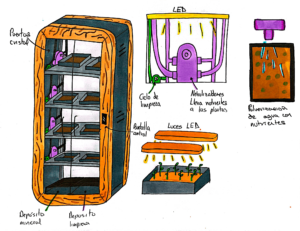Prototypes for Agriculture | Design of Agricultural Machines
Agricultural Machinery Manufacturing and Design Company
The need to create prototypes for agriculture is imminent. The increase and concentration of the population in large urban areas, as well as society's disincentive to engage in agriculture-related activities, have placed the responsibility on this industry to improve procedures and maximize the efficiency of agricultural processes, from the field to logistics. To achieve this, it is necessary to create prototypes and inventions to improve agriculture and its performance.
Types of Companies That Can Create Prototypes for Agriculture:
- Sportech Companies: Sportech companies are organizations dedicated to the creation of useful technological inventions for sports. Most Sportech companies are composed of young profiles with special talent in engineering areas. The main limitations of Sportech companies as technological partners for creating innovative products for sports are usually related to their lack of knowledge about sports practice. Additionally, Sportech startups typically emerge to create their own sports invention, so their goal, besides developing the sports prototype, is to test the invention as soon as possible and commercialize it in the market. While Sportech companies can assist in the development of innovative products for sports, it is important to know that your idea or invention will never be their priority, and you will need an expert in sports practice as part of the team to maintain the balance of "technology - innovation - practical utility".
- Traditional Manufacturers: The best agricultural machinery manufacturers and agricultural tools often have several decades of history. The main agricultural machinery manufacturers are dedicated to optimizing their own agricultural machinery, as well as to their international commercialization. Creating innovative prototypes for agriculture with the best agricultural machinery manufacturers has benefits and some associated risks. The positive aspect of the agricultural machinery manufacturers is their experience and deep knowledge of the main limitations and considerations to take into account in order to design an agricultural machine with high chances of success. On the other hand, the risk of creating prototypes of agricultural machinery or other innovative agricultural products with agricultural machinery manufacturers with such a long history is that they are often not very close to the latest technologies and find it somewhat more difficult to "think outside the box", that is, to seek radical innovation solutions applicable to the agriculture industry. We can summarize it as resistance to radical innovation.
- Open Innovation Companies: The empresas de innovación abierta, o empresas de fabricación de inventos innovadores, concentran sus esfuerzos en integrar diversas disciplinas o ingenierías en un mismo entorno para, trabajando conjuntamente y con máxima coordinación, crear máquinas agrícolas, prototipos para agricultura o prototipos de cualquier industria con alta carga de innovación. Crear prototipos para agricultura con empresas de innovación abierta, también tiene ventajas y desventajas. Lo peor de crear prototipos para agricultura con empresas de innovación abierta o laboratorios de prototipos, es su desconocimiento de los detalles del proceso agrícola. Las principales ventajas de trabajar con este tipo de fábricas de inventos y patentes, es que tienen una visión muy amplia de innovación viable en muchos sectores, aplicables a los prototipos de agricultura, además, suelen tener experiencia creando Innovative products y esto podría ser muy rico para pulir las ideas sobre los nuevos inventos para la agricultura. Para una mejor experiencia trabajando con las fábricas de inventos, es fundamental que trabajen juntos el equipo de ingeniería y desarrollo de productos con el equipo de expertos en agricultura.
Comparison of Agricultural Prototype Design Companies
Agricultural Knowledge
Invention Focus
Innovation Capacity
Agrotech Startups
Medium
Low
High
Agricultural Machinery Manufacturers
High
Low
Medium
Invention and Patent Laboratories
Low
High
High
Agricultural Knowledge
Invention Focus
Innovation Capacity
Agrotech Startups
Medium
Low
High
Agricultural Machinery Manufacturers
High
Low
Medium
Invention and Patent Laboratories
Low
High
High
Agricultural Knowledge | Invention Focus | Innovation Capacity | |
Startups Agrotech | Middle | Low | High |
Agricultural Machinery Manufacturers | High | Low | Middle |
Invention and Patent Laboratories | Low | High | High |
New Trends in Agricultural Prototype Design and Innovation
Pesticide Innovation Prototypes: There are six motivations to focus on innovating agricultural prototypes that minimize or allow for the replacement of pesticide use. Consumer health protection, environmental protection, pest resistance, soil quality, process economy, and food security are the main elements affected or benefited by innovation related to pesticide use.
Precision Agriculture Prototypes: Precision agriculture involves the optimization of resources, time, and effort needed to tend to a crop across its entire extent. The principle of precision agriculture is the knowledge of precise data for specific areas. Precision agriculture prototypes allow for interpreting and detecting the needs of each area, identifying them, and assigning perfectly dosed specific resources to those areas. Innovative precision agriculture products optimize necessary economic resources and maximize crop profitability.
Blockchain Agricultural Prototypes: When we talk about blockchain, we think of Bitcoin and other virtual currencies. The truth is that blockchain is a horizontal technology, useful in many industries, especially when it is necessary to decentralize the possibility of auditing, ensuring that audited data is not corrupt. Blockchain prototypes for agriculture enable efficient traceability analysis, practically from the field to the consumer's table.
Vertical Agriculture Prototypes: The growing need for agricultural products due to the concentration of society in major cities makes it essential to optimize the space used for urban agriculture. This motivation has been key in the development of technologies and prototypes to improve vertical farming techniques. Within vertical agriculture, two types of agricultural prototypes stand out: Hydroponics and Aeroponics, whose definitions are included later.
AI Agricultural Prototypes: Applying artificial intelligence to agricultural prototypes can yield clear benefits, as long as the prototypes have the capacity to learn and predict. In most cases or examples of AI agricultural prototypes where we have had the opportunity to participate, the goal was:
- Predict weather behavior based on historical data. This way, the amount of nutrients and water resources needed for the crop is conditioned.
- Predict the irrigation needs of the crop based on glucose variations in the plants, considering the historical data of each type of crop.
- Customize water dispensing capacity and logic based on climatic data and soil conditions at each point.
- Dispense nutrients in the water accumulation tank for irrigation, based on color variations at the bases of the plants in different parts of the crop.
All these examples of agricultural prototypes highlight the impact of AI on the development of prototypes useful for the development of precision agriculture.
Robotics Agricultural Prototypes: The development of prototypes with electromechanical solutions and robotics has allowed for the optimization of complex and labor-intensive processes with agricultural prototypes that substantially reduce the time, effort, and costs associated with such agricultural procedures. Robotics prototypes for agriculture make a lot of sense in repetitive tasks, such as harvesting and cleaning procedures of cultivated areas.
Clean Energy Agricultural Prototypes: The optimization of renewable energies, also known as clean energy, is mainly limited by exposure times to natural conditions. Therefore, what poses a limitation in large cities makes perfect sense in energy supply systems for useful agricultural prototypes. At Let’s Prototype, we use this type of energy supply system to power agro-climatic stations and other agricultural prototypes that require electronic elements at different points in the plantations.
7 Steps to Create a Prototype for Agriculture, Agricultural Machinery, or Tools
- Definition of the problem.
- Analysis of innovation trends.
- Identification of alternative solutions and state of the art.
- Basic engineering project and technical feasibility.
- Manufacturing of the functional prototype for agriculture..
- Practical testing of the prototype or agricultural machine in the field
- Commercialization of the innovative product.
Step 1 Definition of the problem in agricultural procedures: It is essential to develop a research method that allows, through observation, quantifying the economic impact of the problem. Often, inventors create solutions for problems that are not so severe; this is one of the main causes of prototype failures.
Step 2 Analysis of innovation trends in agriculture: It is crucial to understand the innovation trends in agriculture, latest prototypes in testing stages, and identify solutions that pose direct or substitute competition to the problem you aim to solve.
Step 3 Alternative solutions and state of the art: The analysis of prototypes for agriculture can be conducted through two methods. The first is the analysis of patents for agricultural products. For example, if you want to patent in Spain, you can access the OEPM records and locate similar solutions through practical methods to conduct a background study. In the case of patent registration in the United States, it is even easier to locate patents for similar products. The USPTO system allows filtering by industry, dates, and state from where the patent is applied in the USA. Using these filters, it is essential to understand the inventions that have been patented to solve similar problems. This is crucial because inventors often confidently innovate on inventions believing they haven't found them on the market as a commercial product, but this does not necessarily mean they can be patented, as someone else may have patented a similar system earlier.
Step 4 Engineering project on inventions for agriculture: Engineering projects for agriculture allow demonstrating the technical feasibility of inventions at the laboratory level. This R&D cycle helps mitigate future risks associated with creating inventions that don't exist. Before initiating any prototype manufacturing process for agriculture, it is crucial to demonstrate its technical feasibility and create a sort of prototype manufacturing manual before entering each stage. Even if substantial changes arise later in the agricultural prototype, having invested time and sufficient analysis in its technical feasibility will significantly reduce the cost of the prototype creation cycle.
Step 5 Prototype manufacturing for agriculture: Prototypes for agriculture are experimental products that allow learning about the invention manufacturing process. The creation cycle of a functional prototype, besides practically testing the technical feasibility of the invention, is a fundamental tool for raising funding for the development of a novel product. Skipping the stage of functional prototype manufacturing poses a very high risk, as it is likely that the product cannot be replicated in series production without first going through an experimental manufacturing process that allows for easy and inexpensive changes and improvements.
Step 6 Testing prototypes for agriculture: Prototypes for agriculture face some challenges when it comes to field testing. Issues such as data transmission coverage and access to test environments that simulate or are related to scenarios where the prototype will be used are some of the main barriers that inventors have to overcome.
Step 7 Commercialization of prototypes for agriculture: After conducting functional tests that demonstrate the prototype for agriculture is technically viable and capable of solving real-world problems encountered in the field, another significant challenge arises—demonstrating economic viability. In this regard, conducting commercial experiments is the best solution, even before starting any manufacturing cycle for a series.
What is vertical farming? Prototypes for vertical farming.
Vertical farming systems are those in which crops are cultivated at different heights, allowing for better space utilization and improved control over the crop conditions. The closest analogy to understand vertical farming is comparing it to single-family homes and buildings.
Tipos de sistema de agricultura vertical.
Definition of Hydroponics: Hydroponics is a sustainable vertical farming system, consisting of a column or similar structure capable of supporting plants in support habitats. These support habitats or rings allow roots to be exposed to a nutrient-rich environment for controlled plant growth.
Definition of Aquaponics: Aquaponics is a vertical farming system very similar to Hydroponics. The main difference between these vertical farming systems is that in hydroponics, nutrients are added based on controlled parameters or nutrients in the water tank. In the case of Aquaponics, nutrient balance depends on the waste from fish living within this innovative vertical farming system.
Aeroponics Definition: Unlike the more well-known and popular vertical farming systems like Aquaponics and Hydroponics, aeroponics relies on a sealed structure equipped with sufficient electronic components to continuously measure nutrient levels, light spectra, and other critical parameters for plant growth. In aeroponic systems, plants grow on trays without soil, fully exposed, receiving necessary nutrients directly from the environment. There are clear combinations of artificial intelligence, application development, and mathematical models with aeroponic systems, making it practical to maintain zone-based control, crop types, real-time plant status, nutrient loads, or light spectrum adjustments remotely.
Best vertical farming systems. Differences and similarities.
Hydroponics | Aquaponics | Aeroponics | |
Nutrient acquisition | Dissolved in water. | Aqueous solution derived from fish waste. | Nutrients dispensed in the form of mist. |
Nutrient control | Continuous nutrient monitoring in the tank | Continuous control of the balance between fish and plants. | Nutrient control in the hermetic space of the cabinet. |
Sustainability | Media. Requires addition of non-natural clients. | High. Relies on a natural biological cycle. No external artificial nutrients are added. | Medium. Requires addition of non-natural nutrients. |
Advantages | Accurate control of plant growth | Precise control of plant growth and fish evolution. | Accurate control of plant growth |
Development costs | Middle | Middle | High |
Technical complexity | Media | Media | High |
Examples of inventions and prototypes for Agriculture

Agriculture Prototype 1 – Device for Measuring Glucose in Plants: Glucose indicators in plants allow for diagnosing their capacity in terms of light absorption and necessary nutrient uptake. At Let's Prototype, we have developed a device with electronically democratized components in the market, enabling thorough control of this component using very inexpensive reusable strips. The goal of the innovative agriculture prototype has been to create an electronic device capable of reducing the costs of glucose monitoring systems in plants.
Agriculture Prototype 2 – Aeroponics Device: Based on the knowledge of agriculture experts and client experience, at our invention factory we have been able to manufacture an aeroponics cabinet prototype, equipped with all the necessary electronic systems to efficiently disperse mist, control the durability of mechanical elements, and facilitate the diagnosis and control of parameters within the aeroponics-based agriculture system.
Agriculture Prototype 3 – Combustion Blower and Vacuum: At our prototype design and manufacturing agency, we have built a prototype agricultural machine based on existing blowers that, using a combustion energy system, allows farmers to harvest nuts, olives, and other fruits with an ergonomic and safe agricultural machine, making the harvesting process much more efficient and ergonomic.
Agriculture Prototype 4 – Photometry and Pest Risk Control: Color variations at certain points in the crop are often indicators of inefficiencies in the conventional farming system or the presence of pests, lack of risks among other causes that could jeopardize the crop. Based on the practical experience of the client, we have created a group of electronic devices that are strategically placed in the crop. These electronic devices identify dangerous color variations in the crop, aiming to alert the farmer through a mobile application. This agriculture prototype is based on a combination of devices including custom-made electronic components, telecommunication systems for agriculture, and other technologies that enable preventive crop control, minimizing the farmer's efforts.
Agriculture Prototype 5 – Agricultural Machinery: At Let’s Prototype, we have manufactured agricultural machines designed to minimize the risks faced by farmers in the field, as well as their effort in preventive control and the ergonomics of harvesting, crop cleaning, or planting processes. We have also manufactured prototypes of agricultural machines for domestic use for those urban micro-farming systems or microgreens.
See examples of agricultural prototypes
Inventors with ideas for agricultural prototypes
Who can manufacture an agricultural prototype?
The Agrotech companies, agricultural machinery manufacturers, and prototype design and manufacturing companies are the most common options to create an invention or prototype for agriculture. It is important to consider the experience and capability to integrate new existing agricultural technologies before making a decision.
How much does an agricultural machine prototype cost?
The design of an agricultural prototype can cost between $15,000 and $20,000. The price of an agricultural invention depends on its technical complexity. The cost of designing and creating an invention should be separated from the cost of manufacturing the prototype, which is usually subject to a separate budget.
How long does it take to create an agricultural invention?
The design process of an agricultural prototype can take between 3 to 6 months. The creation period of an agricultural invention depends on the level of uncertainty of its functional principles and the state of the art or background of the invention. This includes whether the background is described in patents or in agricultural products available in the market.
Where do ideas for agricultural inventions originate?
The best source of inspiration for creating novel agricultural inventions is in the field itself. Often, engineers try to create agricultural products that end up solving problems inefficiently or addressing supposed inefficiencies that are not relevant to agricultural experts. To create an agricultural prototype, it is essential to have profiles that are in the field and know the procedures precisely.
¿Can an agricultural invention be patented?
It is possible to patent inventions and prototypes that can be created to improve agricultural procedures. The fundamental requirements for an agricultural prototype patent are to create a novel solution that demonstrates significant improvements in a known and necessary agricultural procedure. The cost of an agricultural patent can range from $10,000 to $15,000. The cost of these patents depends on the market and the number of patented inventions for agriculture in the country where the patent is being filed.

